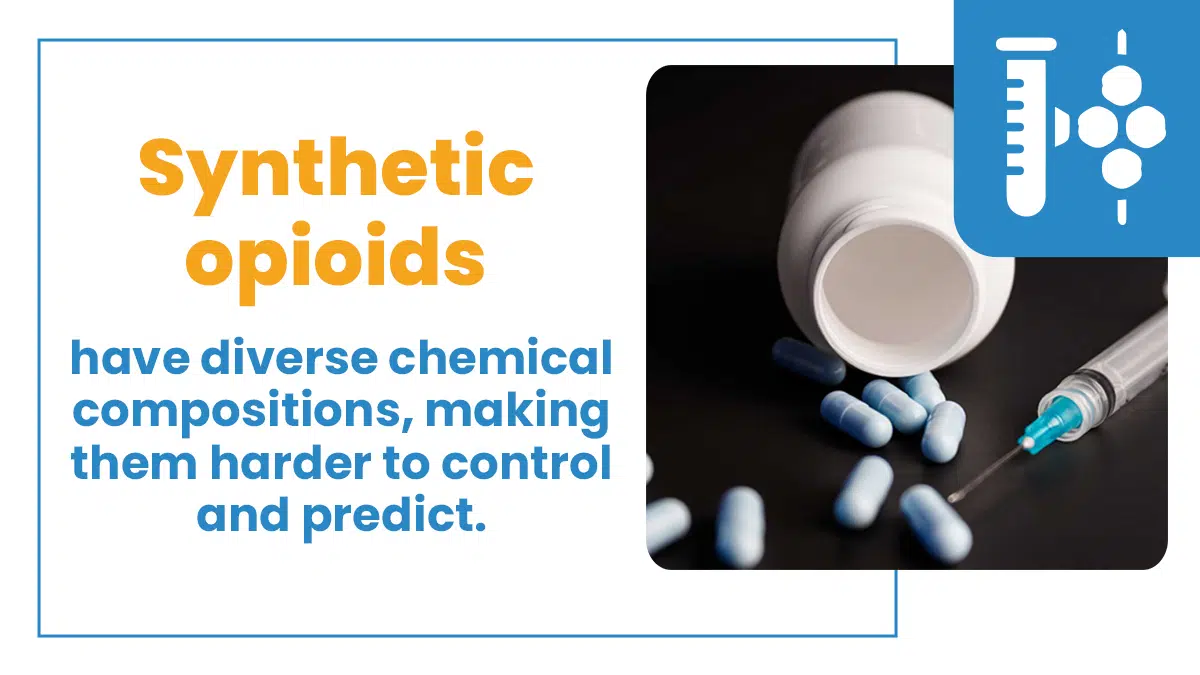Synthetic Opioids: The Silent Crisis
Synthetic opioids, a potent category of pain-relieving drugs, have emerged as a grave concern in the United States. These lab-made substances, unlike naturally derived opioids, pose significant dangers. Their alarming misuse, overdose, and addiction risk make them a critical public health issue.
Synthetic opioids can be several times more potent than conventional ones, making even minor dosage errors life-threatening. Their unpredictable potency amplifies the danger.
These drugs bind to the same brain and body receptors as natural opioids, offering pain relief but carrying substantial risks. This article explores the risks and hazards of synthetic opioids, emphasizing responsible use.
Key Takeaways
In pain management, opioids have long been the go-to for pain relief. However, the rise of synthetic opioids has become a significant crisis in the U.S. Here is what you need to know:
- Synthetic opioids like fentanyl are highly potent, leading to a significant risk of overdose.
- Synthetic opioids have diverse chemical compositions, making them harder to control and predict.
- It is essential to understand the distinctions and dangers between natural and synthetic opioids for effective crisis management.
The Recovery Team is a dedicated facility providing comprehensive support for individuals battling opioid addiction. Contact us at (800) 817-1247 to explore our services.
Opioid Odyssey: Explained The Concept
In pain management, opioids have long held the spotlight. These potent medications are a double-edged sword, offering exceptional pain relief while concealing a perilous blade of addiction and overdose. Opioids, originating from the opium poppy plant or synthesized in labs, bind to specific receptors in the brain and body. They alleviate pain and induce a sense of euphoria.
However, their mesmerizing effects come with an alarming price. The United States faces an opioid crisis, with widespread misuse leading to a surge in addiction and overdose-related deaths.
There are different types of opioids, including natural ones such as morphine and synthetic ones such as fentanyl. Patients and healthcare providers must tread carefully, balancing the need for influential pain management with the potential risks.
History of Synthetic Opioids
Synthetic opioids have played a devastating role in the United States’ opioid crisis. Since the early 2000s, the proliferation of drugs like fentanyl and its analogs has dramatically increased overdose deaths.
According to the Centers for Disease Control and Prevention (CDC), in 2019, over 50,000 opioid overdose deaths occurred, with synthetic opioids contributing to a significant portion. The history of synthetic opioids is marked by their illicit production, distribution, and role in one of the deadliest drug epidemics in U.S. history.
Early Developments in Synthetic Opioids
The history of synthetic opioids begins with the quest to create potent pain-relief medications. During the mid-20th century, pharmaceutical companies were focused on creating powerful pain relievers.
One of the most iconic milestones was the emergence of fentanyl in the 1960s, prized for its remarkable potency. This synthetic opioid soon found its place in medical practice, especially for managing severe pain.
Over the years, pharmaceutical innovation led to various synthetic opioids, each tailored for specific medical purposes. However, the 21st century witnessed a shift, with some potent opioids becoming sources of concern as they entered the illicit drug market, exacerbating the opioid crisis in the United States.
Modern Advancements in Synthetic Opioids
In recent years, modern advancements in synthetic opioids have continued to shape the landscape of pain management and public health. Pharmaceutical companies have developed new variations with enhanced properties, such as extended-release formulations for chronic pain. These advancements have aimed to balance adequate pain relief and minimize addiction and overdose risk.
However, modern developments have also brought forth challenges. The illicit manufacturing and distribution of potent synthetic opioids, such as carfentanil, have exacerbated the opioid crisis in the United States.
This crisis led to a surge in overdose-related fatalities. Striking the right balance between legitimate medical use and the prevention of misuse remains an ongoing concern in synthetic opioids.
Examples of Synthetic Opioids
Synthetic opioids are manufactured substances designed to mimic the effects of natural opioids. These substances come in many forms and have different chemical structures, each contributing to their unique properties and risks. Let’s learn the overview of different categories.
Fentanyl
Fentanyl is the most potent synthetic opioid that has garnered substantial attention due to its role in the opioid epidemic. It is considered 50 to 100 times more potent than morphine, making even tiny amounts potentially lethal.
Initially developed for medical use, fentanyl is prescribed to manage severe pain, especially after surgery or for cancer patients. However, its illicit production and distribution have led to widespread abuse and countless overdose deaths.
Fentanyl is often mixed with other drugs, further increasing the risk. The opioid crisis has prompted efforts to control fentanyl‘s availability and raise awareness about its dangers, with law enforcement, healthcare professionals, and policymakers working to combat its devastating impact.
Methadone
Methadone is another synthetic opioid primarily used in the treatment of opioid dependence and pain management. It is distinct from other opioids due to its longer-lasting effects, making it suitable for addressing opioid withdrawal symptoms and cravings.
Addiction treatment is administered through specialized clinics, where patients can receive daily doses to reduce withdrawal discomfort and prevent drug-seeking behavior. Methadone’s slow onset and sustained action minimize the euphoria and cravings associated with other opioids, thus assisting individuals on their path to recovery.
While effective under medical supervision, improper use or dosage can lead to dependence. It emphasizes the importance of close monitoring and appropriate administration.
Tramadol
The third synthetic opioid analgesic is tramadol, which manages moderate to severe pain. It’s distinct from many other opioids in that it combines opioid effects with the modulation of certain neurotransmitters in the brain. This dual action makes it a popular choice for various types of pain, from post-surgical to chronic conditions like osteoarthritis.
Tramadol is often considered a safer alternative to more potent opioids due to its lower potential for abuse and addiction. However, it’s not entirely free of these risks, and misuse can still lead to dependency and adverse side effects.
Therefore, medical supervision and adherence to prescribed dosages are crucial when using tramadol to maximize its benefits while minimizing potential harm.
Carfentanil
Carfentanil is a highly potent opioid used primarily as a tranquilizer for large animals like elephants and is not intended for human consumption. It is estimated to be 100 times more influential than fentanyl and 10,000 times more potent than morphine.
Due to its extreme potency, even minuscule amounts can cause severe, often fatal, respiratory depression in humans. Carfentanil has gained notoriety for its involvement in the opioid crisis, as it is sometimes found laced with illicit drugs, particularly heroin.
Synthetic Opioids and the Opioid Crisis
Synthetic opioids have played a central and devastating role in the opioid crisis. This crisis, characterized by a staggering increase in opioid-related deaths and addiction rates, can be attributed mainly to the proliferation of these artificial substances.
One of the counter ways synthetic opioids have contributed to the crisis is through their exceptional potency. Substances like fentanyl and carfentanil, often mixed with other drugs or sold as counterfeit prescription medications, are exponentially more potent than traditional opioids. Even tiny miscalculations in dosing can lead to fatal overdoses, making them especially dangerous.
Moreover, the clandestine production and distribution of synthetic opioids have made them readily available on the black market, exacerbating the crisis.
People often unknowingly consume these substances, thinking they take a less potent drug. The widespread misuse of prescription opioids and the subsequent transition to these high synthetics have fueled the crisis.
In response, the U.S. government and healthcare professionals have implemented measures to tackle the crisis, including increased regulation, education, and expanded access to addiction treatment. Still, there is a need for continued vigilance and proactive solutions.
Dangers and Risks of Synthetic Opioids
Synthetic opioids pose a multifaceted and severe threat, characterized by a range of dangers and risks, including:
Overdose and Death
Fentanyl and carfentanil are exceptionally potent. Even minuscule miscalculations in dosing can lead to rapid and life-threatening respiratory depression. It has contributed significantly to the alarming increase in opioid-related overdose deaths across the United States.
Addiction and Dependence
These substances are highly addictive, both psychologically and physically. Regular use can lead to a quick development of tolerance, forcing individuals to consume increasingly higher doses to achieve the desired effects. This cycle of escalation often results in a severe and inescapable dependence.
Physical and Mental Health Risks
Chronic use of synthetic opioids can lead to many physical health issues, such as heart problems, liver damage, and respiratory disorders. Mental health consequences include depression, anxiety, and cognitive impairments.
Moreover, the lifestyle associated with opioid addiction can lead to social isolation, loss of employment, and legal troubles. Address the synthetic opioid crisis and implement comprehensive prevention, harm reduction, and treatment strategies.
Synthetic Opioid Abuse
Synthetic opioid abuse is a grave concern. It leads to a high risk of overdose and addiction, with severe physical and mental health consequences. Addressing this crisis necessitates early recognition, treatment access, and effective prevention strategies to curb the devastating impact on individuals and communities.
Identifying the Signs
Behavioral Changes: Look for sudden shifts in behavior, such as increased secrecy, social withdrawal, or a decline in responsibilities and personal hygiene.
Physical Signs: Dilated pupils, nodding off, or slurred speech are potential indicators of opioid abuse.
Neglecting Responsibilities: Missing work or school, neglecting family or financial responsibilities, and legal troubles may result from addiction.
Seeking Prescription Medications: Frequent doctor visits or attempts to obtain prescription opioids can be signs of misuse.
Treatment Options: Path to Recovery
Medical Detox: Professional medical supervision during detoxification can help manage withdrawal symptoms safely.
Medication-Assisted Treatment (MAT): Medications like methadone or buprenorphine can reduce cravings and withdrawal symptoms, increasing the chances of recovery in medication-assisted treatment.
Behavioral Therapy: Cognitive-behavioral therapy (CBT) and contingency management effectively address the psychological aspects of addiction.
Support Groups: Participating in 12-step programs or group therapy can provide essential peer support.
Prevention Strategies
Education: Raising awareness about the risks of synthetic opioids is crucial, targeting both the general public and healthcare providers.
Prescription Monitoring: Enhance prescription drug monitoring programs to prevent the diversion of prescription opioids to the black market.
Harm Reduction: Implement harm reduction strategies such as supervised injection sites, access to naloxone, and clean needle exchanges to reduce overdose deaths.
Early Intervention: Identify and intervene with at-risk individuals, providing them with support and resources to prevent addiction.
To combat synthetic opioid abuse and save lives, we must implement prevention measures, recognize signs, and promote accessible treatment options.






